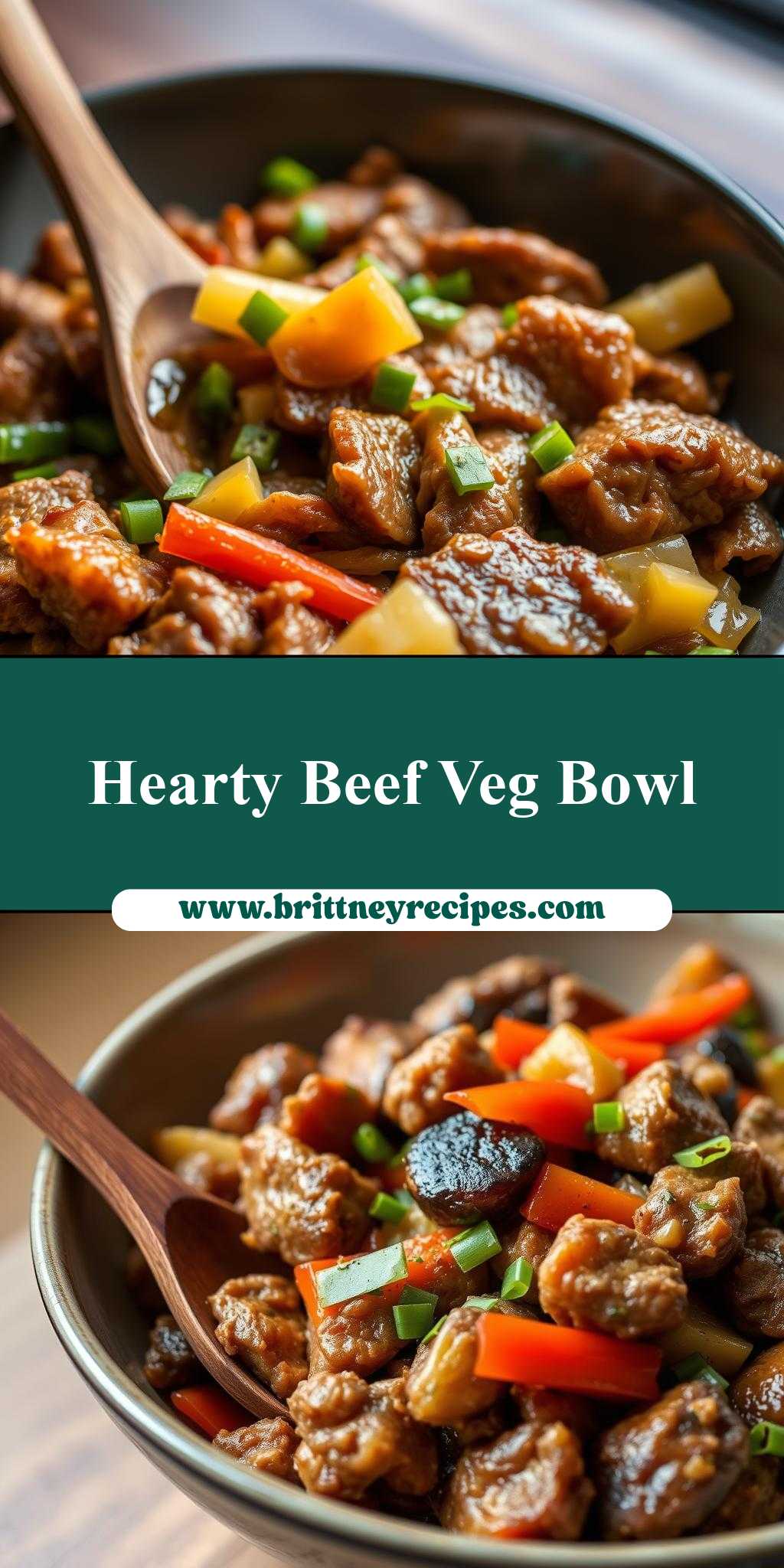What makes a hearty bowl of homemade goodness so satisfying? This easy weeknight dinner is packed with tender meat and roasted veggies, all perfectly balanced with a rich homemade broth and finished with a sprinkle of fresh herbs, try cooking it low and slow for maximum flavor, save this idea for a cozy night in.
a bowl filled with meat and veggies next to a wooden spoon in it
Introduction
Imagine a dish that combines the savory flavors of meat and the freshness of vegetables, all in one harmonious bowl. This recipe for a bowl filled with meat and veggies next to a wooden spoon in it is not just about the ingredients, but about the experience of creating and savoring a meal that’s both nourishing and delicious. With everyday ingredients and a straightforward preparation process, this dish is perfect for a weeknight dinner or a weekend brunch. It’s a celebration of flavors, textures, and the joy of cooking with love.
Why This Works
- Flavor balance and ingredient accessibility: The combination of meat and vegetables provides a balanced mix of proteins, vitamins, and minerals, making it a nutritious option. The ingredients are also easily accessible in most supermarkets, allowing for flexibility and creativity in substitutions.
- Ease of preparation: The steps involved in preparing this dish are simple and require minimal cooking skills, making it perfect for beginners or those looking for a quick meal solution.
- Impressive results with minimal effort: Despite its simplicity, the presentation and flavors of this dish are impressive, making it suitable for serving guests or enjoying a special meal with family.
Key Ingredients
The main ingredients for this recipe include 1 tablespoon of olive oil, 2 chicken breasts (or tofu for a vegetarian option), 1 bell pepper sliced, 1 onion chopped, 2 cloves of garlic minced, and your choice of seasonings such as salt, pepper, and any other herbs or spices you prefer. For practical substitutions, you can use different types of meat or vegetables based on your dietary preferences or what’s available in your pantry.
Instructions
- Step 1: Begin by preparing your ingredients. Chop the onion and bell pepper, mince the garlic, and season the chicken breasts with your chosen herbs and spices.
- Step 2: Heat the olive oil in a large pan over medium heat. Add the chicken and cook until it’s browned on both sides and cooked through. Remove the chicken from the pan and set it aside.
- Step 3: In the same pan, add the chopped onion and minced garlic. Sauté until the onion is translucent, then add the sliced bell pepper. Continue to sauté until the vegetables are tender.
- Step 4: To assemble the dish, slice the cooked chicken and place it in a bowl. Add the sautéed vegetables on top of the chicken. You can add any additional seasonings or garnishes you like, such as a sprinkle of parsley or a squeeze of lemon juice.
Handy Tips
- For a crisper texture on the chicken, make sure to pat it dry with a paper towel before seasoning and cooking. This helps the seasonings stick better and promotes even browning.
- If using wooden utensils like a wooden spoon, avoid exposing them to high heat for extended periods, as this can cause damage or discoloration.
- Consider the color and texture variety when selecting vegetables to ensure a visually appealing dish. Mixing different colors and textures can make the meal more engaging and enjoyable.
Heat Control
When cooking the chicken and vegetables, maintaining the right heat is crucial. For the chicken, cook over medium heat to prevent burning the outside before the inside is fully cooked. For the vegetables, a medium to low heat can help them sauté slowly and evenly, bringing out their natural sweetness without burning. Always check for doneness by ensuring the chicken is cooked through and the vegetables are tender but still crisp.
Crunch Factor
Achieving the right crunch factor can elevate the dish. For the vegetables, sauté them until they are tender but still retain some crunch. This can be achieved by not overcooking them. If you prefer a crisper texture on your chicken, you can finish it off under the broiler for a few minutes or cook it in a skillet with a small amount of oil until the outside is crispy.
Pro Kitchen Tricks
- Marinating the chicken before cooking can add deeper flavors. Even a quick 30-minute marinade in your favorite seasonings can make a difference.
- Using a cast-iron skillet can help retain heat and distribute it evenly, which is perfect for cooking the chicken and vegetables.
- For easier cleanup, line your pans with parchment paper or aluminum foil before cooking. This trick is especially helpful when cooking messy or sticky foods.
Storage Tips
- Leftovers can be stored in an airtight container in the refrigerator for up to 3 days. Reheat gently in the microwave or on the stovetop until warmed through.
- For longer storage, consider freezing the cooked chicken and vegetables separately. They can be reheated as needed for future meals.
- When reheating, make sure the food is heated to an internal temperature of at least 165°F (74°C) to ensure food safety.
Gift Packaging Ideas
If you’re considering gifting this dish, it can be beautifully presented in a mason jar or a decorative bowl, topped with fresh herbs or edible flowers. Wrap the container in a cloth or paper bag and tie with a ribbon for a rustic, homemade touch. Include a wooden spoon as a thoughtful addition, symbolizing the warmth and love that goes into preparing a meal for someone else.
Flavor Variations
- Different spices: Experiment with various spice blends like Italian seasoning, Mexican fajita seasoning, or Indian curry powder to give the dish a unique flavor profile.
- Creative toppings: Add some crunch with toasted nuts or seeds, a burst of freshness with diced tomatoes or avocado, or a tangy kick with a dollop of yogurt or sour cream.
- Ingredient swaps: Substitute chicken with beef, pork, tofu, or tempeh for a protein change. Swap out vegetables based on what’s in season or your personal preferences.
Troubleshooting
- Texture problems: If the chicken is too dry, it might have been overcooked. Try cooking it for less time or using a meat thermometer to ensure it reaches a safe internal temperature without overcooking. For vegetables that are too mushy, reduce the cooking time or cook them with a bit more oil to prevent them from steaming instead of sautéing.
- Ingredient replacements: If you’re missing an ingredient, look for substitutes that offer similar texture or flavor. For example, if you don’t have bell peppers, zucchini or carrots could work as alternatives.
- Over/undercooking signs: Always check your chicken for doneness by cutting into it; if it’s pink, it needs more cooking time. For vegetables, taste them periodically as they cook to determine if they’ve reached your desired level of tenderness.
FAQs
- Can I freeze it? Yes, both the cooked chicken and vegetables can be frozen for later use. It’s best to freeze them separately for easier reheating and to prevent the vegetables from becoming mushy.
- Is it gluten-free? This recipe is naturally gluten-free, making it a great option for those with gluten intolerance or sensitivity. However, always check the ingredients of any store-bought seasonings or sauces to ensure they are gluten-free.
- Can I double the recipe? Absolutely, this recipe can be easily doubled or tripled to feed a larger crowd. Just remember to adjust the cooking time slightly if you’re cooking a larger quantity of chicken or vegetables.
Conclusion
This recipe for a bowl filled with meat and veggies next to a wooden spoon in it is a testament to the simplicity and joy of cooking. It’s a dish that encourages creativity, flexibility, and the use of everyday ingredients to create something truly special. Whether you’re a seasoned chef or a beginner in the kitchen, this recipe is sure to delight. So go ahead, experiment with different flavors, share it with loved ones, and enjoy the process of cooking a meal that’s not just about sustenance, but about connection and love.

